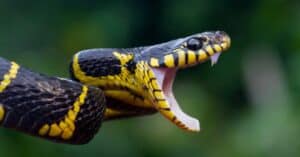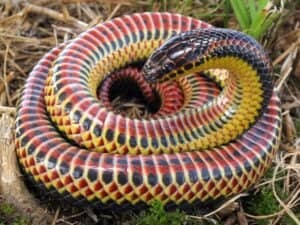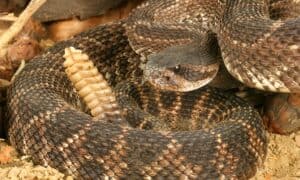Honey Badger Vs Komodo Dragon: Who Would Win in a Fight?
Given a choice between facing down a honey badger or a Komodo dragon, most people would say it doesn’t matter. They’re both hyper-aggressive creatures that regularly take down and kill prey that is much larger than them. Following in the line of that “what if” scenario, we have to wonder what would happen if a honey badger from Africa managed to make its way to Southeast Asia and came face-to-face with a Komodo dragon. We’re going to break down a honey badger vs Komodo dragon fight and tell you which creature has the highest chance of winning.
Comparing a Honey Badger and a Komodo Dragon

A-Z-Animals.com
| Honey Badger | Komodo Dragon | |
| Size | Weight: 11lbs to 40lbs Length: 1.5ft – 2.5ft |
Weight: 150lbs – 300lbs Length: 6ft-10ft |
| Speed and Movement Type | – 19 mph top speed | 11 mph top speed |
| Senses | – Great sense of smell – Good sense of hearing – Poor eyesight like most other Mustelids |
– Good eyesight – Use their tongues and Jacobson’s organ to smell and taste their environment and find prey from miles away – Poor hearing |
| Defenses | – Exceptionally thick skin that resists bites, stabs, stings, and blows – Overpowering musk that can make predators flee |
– Hard skin with strong scales that are reinforced with bony deposits called osteoderms – Speed |
| Offensive Capabilities | – Sharp claws – Powerful, well-aimed bites – Can turn the tables on enemies in close quarters |
– Possibly venomous – Sharp claws hold prey in place – Sharp teeth lead to exsanguination in victims |
| Predatory Behavior | – Pursuit predators – Their teeth are sharp enough and their jaws powerful enough to break through tortoise shells. – Digs prey out of burrows |
– Ambush predators – Tries to knock down and bite vital areas on prey, typically the neck. |
What Are Key Differences Between a Honey Badger and a Komodo Dragon?
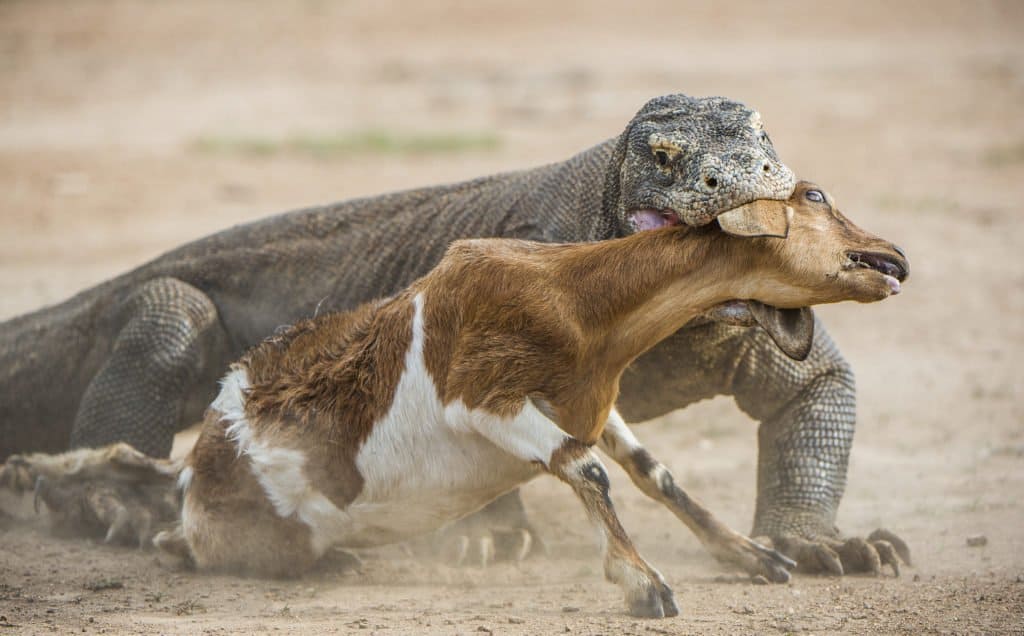
The biggest differences between honey badgers and Komodo dragons include their size and morphology. Komodo dragons are far larger than honey badgers, have lizard-like bodies rather than a quadrupedal mammal body, and also have reinforced scaly skin rather than the thick hide of a honey badger.
These differences are profound and greatly impact the way that a battle between these animals would develop. We’re going to explore these unique qualities more and look at other important features of these animals as they pertain to battle as well.
What Are the Key Factors in a Fight Between a Honey Badger and a Komodo Dragon?

A honey badger vs Komodo dragon fight would be decided by many factors. It’s widely known that honey badgers have no problem confronting larger, more dangerous carnivores. Yet, if they did choose to engage a Komodo dragon in a fight, what is their path to victory?
We’re going to look at physical elements as well as how these two creatures approach combat. By looking at five different points of data, we’ll determine which animal is poised to be the winner.
Honey Badger vs Komodo Dragon: Size
Komodo dragons are much larger than honey badgers. Honey badgers weigh up to 40lbs and grow about 2.5ft in length. They’re smaller than many breeds of dog, and they are utterly dwarfed by Komodo dragons. Komodo dragons can measure 10ft in length and will weigh anywhere between 150lbs and 300lbs. The largest Komodo dragon on record weighed 365 pounds, about 10 times larger than a honey badger.
Komodo dragons have the size advantage in this situation.
Honey Badger vs Komodo Dragon: Speed and Movement
Honey badgers are quicker than Komodo dragons. They can run at 19 mph, but Komodo dragons can run at 11 mph. Honey badgers use their speed to dodge, harry, and launch deadly counterattacks against their foes.
Overall, honey badgers have the speed advantage by a fair margin.
Honey Badger vs Komodo Dragon: Senses
Honey badgers have poor eyesight like other members of their family, like wolverines. They have an exceptional sense of smell and hearing that they use to locate their prey and root it out of its hiding spot.
Komodo dragons have good eyesight and the ability to use their specialized Jacobson’s organ to sense their environment and find prey that is very far away. Their hearing is poor, though.
Komodo dragons have the advantage in terms of senses because of their specialized organs that help them hunt.
Honey Badger vs Komodo Dragon: Physical Defenses
Honey badgers have powerful defenses that will help them in this fight. They have a very thick hide that hangs loosely on some parts of their bodies. When they get grabbed by a foe, they can somewhat turn around inside their skin and bite their enemy.
Also, they have a pungent musk that they emit to scare off foes. Honey badgers are known for being resistant to many kinds of venom. Komodo dragons aren’t venomous in the typical sense. Even if they were, honey badgers wouldn’t have a resistance to it.
Meanwhile, Komodo dragons have scaly skin that is lined with osteoderms, bony protrusions that can limit biting and clawing attacks. Both animals are surprisingly fast, too, and they can run from the fight.
Komodo dragons are better suited for this fight, so they have the defensive advantage.
Honey Badger vs Komodo Dragon: Combat Skills
Honey badgers fight by clawing their foes, choking them with musk, and using well-aimed bites to kill their enemies. Their jaws and ingenuity help them break tortoise shells to kill the animal within and even dig the prey out of their burrows.
Komodo dragons might be venomous and use their sharp claws and weight to hold prey in place while they bite it to death. Their teeth are sharp enough to cause severe lacerations, and their saliva may induce shock and act as an anti-coagulant.
Needless to say, both creatures come to this fight ready to battle.
Who Would Win in a Fight Between a Honey Badger and a Komodo Dragon?
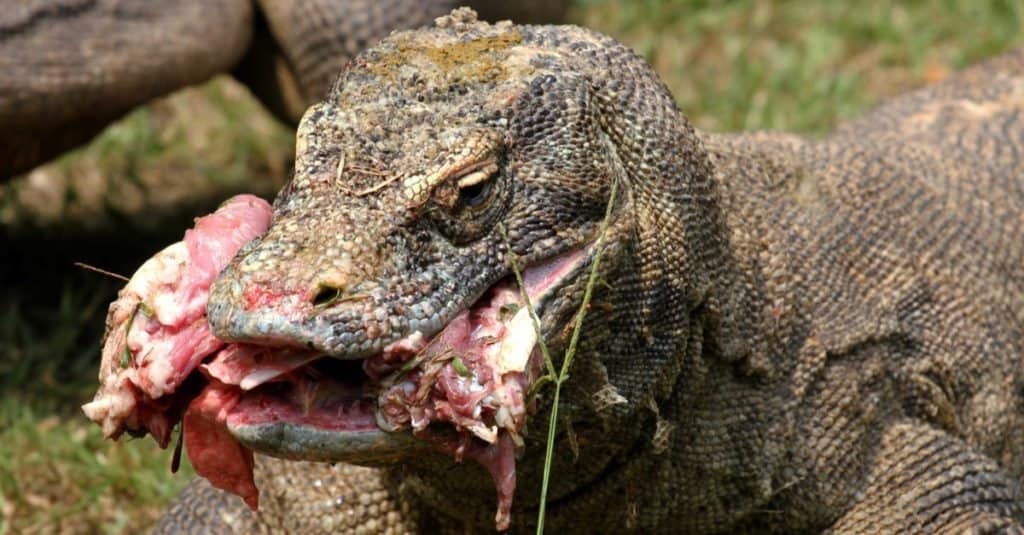
Yudi S/Shutterstock.com
A Komodo dragon would win a fight against a honey badger. Although honey badgers have a lot of endurance and tenacity, the fact is that they cannot deal fatal damage to the large lizard.
A Komodo dragon and a honey badger would certainly know the other creature is in their territory due to their great predators’ senses. They’ll face off against each other in an open, flat area. The honey badger would likely use its superior speed to dodge the Komodo dragon’s opening foray. Then, it would look for openings, taking a bite of its tail or flank to turn the foe.
Eventually, the honey badger will try for a serious attack, emitting musk and delivering bites only to find that it cannot do much damage to the Komodo dragon owing to its powerful scaly skin. From this point on, only two results are possible. In one case, the honey badger can flee because it has the speed advantage and endurance that exceeds most animals.
Otherwise, the Komodo dragon will eventually get its claws into the honey badger and deliver enough bites to exsanguinate the honey badger. It might take some damage on its face and underside while attempting to kill its foe. Either way, the honey badger meets its match against the Komodo dragon.
More from A-Z Animals
Given a choice between facing down a honey badger or a Komodo dragon, most people would say it doesn’t matter. They’re both hyper-aggressive creatures that regularly take down and kill prey that is much larger than them. Following in the line of that “what if” scenario, we have to wonder what would happen if a honey badger from Africa managed to make its way to Southeast Asia and came face-to-face with a Komodo dragon. We’re going to break down a honey badger vs Komodo dragon fight and tell you which creature has the highest chance of winning.
Comparing a Honey Badger and a Komodo Dragon

A-Z-Animals.com
| Honey Badger | Komodo Dragon | |
| Size | Weight: 11lbs to 40lbs Length: 1.5ft – 2.5ft |
Weight: 150lbs – 300lbs Length: 6ft-10ft |
| Speed and Movement Type | – 19 mph top speed | 11 mph top speed |
| Senses | – Great sense of smell – Good sense of hearing – Poor eyesight like most other Mustelids |
– Good eyesight – Use their tongues and Jacobson’s organ to smell and taste their environment and find prey from miles away – Poor hearing |
| Defenses | – Exceptionally thick skin that resists bites, stabs, stings, and blows – Overpowering musk that can make predators flee |
– Hard skin with strong scales that are reinforced with bony deposits called osteoderms – Speed |
| Offensive Capabilities | – Sharp claws – Powerful, well-aimed bites – Can turn the tables on enemies in close quarters |
– Possibly venomous – Sharp claws hold prey in place – Sharp teeth lead to exsanguination in victims |
| Predatory Behavior | – Pursuit predators – Their teeth are sharp enough and their jaws powerful enough to break through tortoise shells. – Digs prey out of burrows |
– Ambush predators – Tries to knock down and bite vital areas on prey, typically the neck. |
What Are Key Differences Between a Honey Badger and a Komodo Dragon?

The biggest differences between honey badgers and Komodo dragons include their size and morphology. Komodo dragons are far larger than honey badgers, have lizard-like bodies rather than a quadrupedal mammal body, and also have reinforced scaly skin rather than the thick hide of a honey badger.
These differences are profound and greatly impact the way that a battle between these animals would develop. We’re going to explore these unique qualities more and look at other important features of these animals as they pertain to battle as well.
What Are the Key Factors in a Fight Between a Honey Badger and a Komodo Dragon?

A honey badger vs Komodo dragon fight would be decided by many factors. It’s widely known that honey badgers have no problem confronting larger, more dangerous carnivores. Yet, if they did choose to engage a Komodo dragon in a fight, what is their path to victory?
We’re going to look at physical elements as well as how these two creatures approach combat. By looking at five different points of data, we’ll determine which animal is poised to be the winner.
Honey Badger vs Komodo Dragon: Size
Komodo dragons are much larger than honey badgers. Honey badgers weigh up to 40lbs and grow about 2.5ft in length. They’re smaller than many breeds of dog, and they are utterly dwarfed by Komodo dragons. Komodo dragons can measure 10ft in length and will weigh anywhere between 150lbs and 300lbs. The largest Komodo dragon on record weighed 365 pounds, about 10 times larger than a honey badger.
Komodo dragons have the size advantage in this situation.
Honey Badger vs Komodo Dragon: Speed and Movement
Honey badgers are quicker than Komodo dragons. They can run at 19 mph, but Komodo dragons can run at 11 mph. Honey badgers use their speed to dodge, harry, and launch deadly counterattacks against their foes.
Overall, honey badgers have the speed advantage by a fair margin.
Honey Badger vs Komodo Dragon: Senses
Honey badgers have poor eyesight like other members of their family, like wolverines. They have an exceptional sense of smell and hearing that they use to locate their prey and root it out of its hiding spot.
Komodo dragons have good eyesight and the ability to use their specialized Jacobson’s organ to sense their environment and find prey that is very far away. Their hearing is poor, though.
Komodo dragons have the advantage in terms of senses because of their specialized organs that help them hunt.
Honey Badger vs Komodo Dragon: Physical Defenses
Honey badgers have powerful defenses that will help them in this fight. They have a very thick hide that hangs loosely on some parts of their bodies. When they get grabbed by a foe, they can somewhat turn around inside their skin and bite their enemy.
Also, they have a pungent musk that they emit to scare off foes. Honey badgers are known for being resistant to many kinds of venom. Komodo dragons aren’t venomous in the typical sense. Even if they were, honey badgers wouldn’t have a resistance to it.
Meanwhile, Komodo dragons have scaly skin that is lined with osteoderms, bony protrusions that can limit biting and clawing attacks. Both animals are surprisingly fast, too, and they can run from the fight.
Komodo dragons are better suited for this fight, so they have the defensive advantage.
Honey Badger vs Komodo Dragon: Combat Skills
Honey badgers fight by clawing their foes, choking them with musk, and using well-aimed bites to kill their enemies. Their jaws and ingenuity help them break tortoise shells to kill the animal within and even dig the prey out of their burrows.
Komodo dragons might be venomous and use their sharp claws and weight to hold prey in place while they bite it to death. Their teeth are sharp enough to cause severe lacerations, and their saliva may induce shock and act as an anti-coagulant.
Needless to say, both creatures come to this fight ready to battle.
Who Would Win in a Fight Between a Honey Badger and a Komodo Dragon?

Yudi S/Shutterstock.com
A Komodo dragon would win a fight against a honey badger. Although honey badgers have a lot of endurance and tenacity, the fact is that they cannot deal fatal damage to the large lizard.
A Komodo dragon and a honey badger would certainly know the other creature is in their territory due to their great predators’ senses. They’ll face off against each other in an open, flat area. The honey badger would likely use its superior speed to dodge the Komodo dragon’s opening foray. Then, it would look for openings, taking a bite of its tail or flank to turn the foe.
Eventually, the honey badger will try for a serious attack, emitting musk and delivering bites only to find that it cannot do much damage to the Komodo dragon owing to its powerful scaly skin. From this point on, only two results are possible. In one case, the honey badger can flee because it has the speed advantage and endurance that exceeds most animals.
Otherwise, the Komodo dragon will eventually get its claws into the honey badger and deliver enough bites to exsanguinate the honey badger. It might take some damage on its face and underside while attempting to kill its foe. Either way, the honey badger meets its match against the Komodo dragon.




